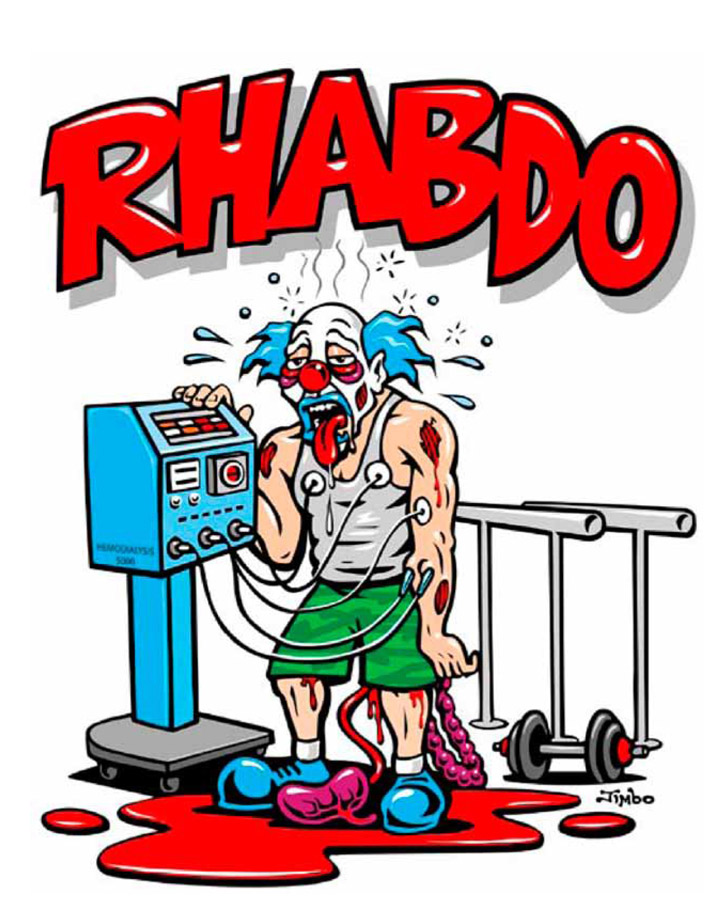WATCH: Dr. Mark Tarnopolsky is considered an expert in rhabdomyolysis. He has seen cases double in the past few years.

TORONTO – Your legs are shaking and buckling, the rest of your body is shuddering in pain whenever you move, and your urine turns red, “Coca-Cola brown” or even black.
These are the hallmark signs of rhabdomyolysis, a condition in which your body’s muscles break down. It used to be common in army training but with the rise of military-style workouts, everyday exercisers could be at risk. And the consequences could be fatal.
“If you’re working out on a regular basis, and you’re accustomed to the activity, it would be extremely unlikely to experience rhabdomyolysis. It’s more common when someone does unaccustomed activity,” Dr. Mark Tarnopolsky, a researcher at McMaster University Medical Centre, told 16×9.
That could mean returning to a strenuous weight lifting regime you abandoned six months ago, or training for a 10K race then deciding to run a marathon instead.
A workout that led to the emergency room
Take Jay Armitage. For the most part, she considered herself fit and healthy, heading to the gym at least three times a week. But that stopped after taking on an important project at work that kept her out of the gym while eating out with clients for three months.
When she headed to her first Spartan workout class — similar a boot camp or CrossFit training — she kept up, but quickly felt the burn.
“We’re talking kettle bells, we’re talking burpees, endless amounts of using your own body weight to do sumo squats, push ups and it just went on…,” she said.
She knew this was a different workout than she’d ever done.
The next day, Armitage was in agony. She couldn’t move her arms far back enough to do her hair, or even put on her pants.
“I had never experienced pain like this. I had experienced ‘I feel sore after a workout that felt like a good workout’…this was drastically different than that,” she said.
“This is every little muscle in your body hurts when you move it. This is an incredible amount of pain and there is also some swelling.”
After a few medical tests, doctors confirmed Armitage had rhabdomyolysis. She headed straight to a hospital for treatment.
What is rhabdomyolysis?
There is always some muscle damage after a workout, but it veers into dangerous territory when exercisers dramatically overexert themselves.
“Someone is so sore that they’re having problems getting out of a chair, walking downstairs…or if they have urine that was turning red, tea-coloured brown,” Tarnopolsky explained.
Rhabdomylosis is the breakdown of muscle. Muscles have an outer coating, but if they’re stressed metabolically, the trauma can cause a rupture.
“And then some of the contents of muscle come out into the blood, things like CK, AST, and a variety of different enzymes, which can eventually end up damaging your kidney,” Tarnopolsky explained.
It first appeared during wars — soldiers would face crushing injuries, from say, bullet wounds or something falling on their legs that would damage muscles. Even in training, unprepared soldiers would get ill from high-intensity training. By the 70s, marathoners proved they could also deal with bouts of rhabdomyolysis.
While in treatment, doctors monitor urine, electrolytes and creatine kinase, one of the enzymes that indicate the degree of damage to their patient’s muscles. The protein leaks out of the damaged muscles.
- Posters promoting ‘Steal From Loblaws Day’ are circulating. How did we get here?
- Video shows Ontario police sharing Trudeau’s location with protester, investigation launched
- Canadian food banks are on the brink: ‘This is not a sustainable situation’
- Solar eclipse eye damage: More than 160 cases reported in Ontario, Quebec
A nurse who was treating Armitage told her she hadn’t seen higher CK levels on any other patient in her life. Normal levels range between 120 and 150. Hers was hovering at around 95,000.
Armitage had what she called “Popeye arms” because they were so swollen, “like blown-up balloons.”
Watch the video below: Devin Radcliffe, a former Canadian soldier, pushed himself too far in a CrossFit workout. He almost died after getting rhabdomyolysis.
Doctors were afraid she’d deal with kidney damage or kidney failure — Armitage only had one kidney to begin with so they worked quickly to get started on flushing out her dying muscle cells.
Military-style workouts, testing physical limits on the rise
And with the increase in CrossFit training, Tough Mudder and Spartan Races and even military-style boot camps comes a growing fascination with rhabdomyolysis.
The medical condition is even worn as a badge of honour, of showcasing an athlete pushing his or her physical limits.
CrossFit’s own’s counter-culture image comes with Pukey the Clown, in which some exercisers say they worked out so hard, they threw up.
Then there’s Uncle Rhabdo, a clown with kidneys dangling onto the floor while he’s hooked up to a dialysis machine.
Tarnopolsky said that these mascots make light of a serious condition.
“If you don’t die, you might end up in (the emergency room), kidney failure needing dialysis for the rest of your life,” Tarnopolsky said.
Rhabdomyolysis from overexerting yourself is completely avoidable, too.
Tarnopolsky has seen power lifters and body builders train without ever facing any symptoms of rhabdo. It’s the people who push their bodies too quickly and too intensely that end up hurting.
“You can’t jump in and bench press 250 pounds. I mean the body physically just can’t do it,” he said.
The American College of Sports Medicine provides guidelines on nutrition, exercise training and hydration but the everyday exerciser doesn’t easily interpret them. Ultimately, it’s on personal trainers, kinesiologists and health care providers to assess the advice and help their clients, Tarnopolsky said.
Read more about rhabdomyolysis here.
carmen.chai@globalnews.ca
Follow @Carmen_Chai








Comments